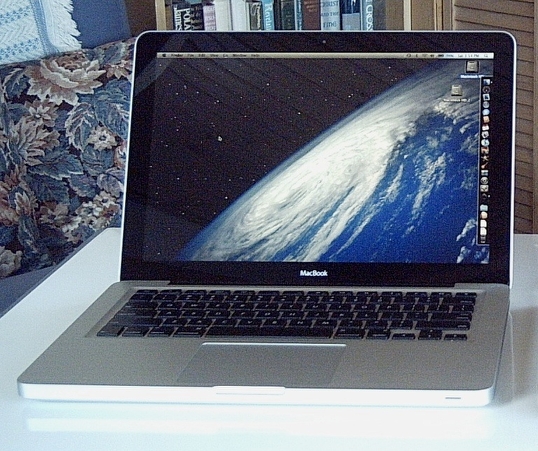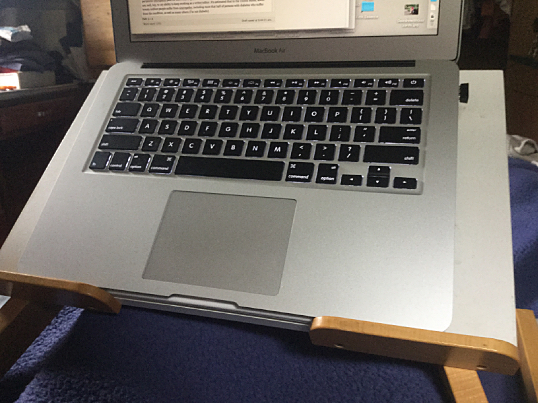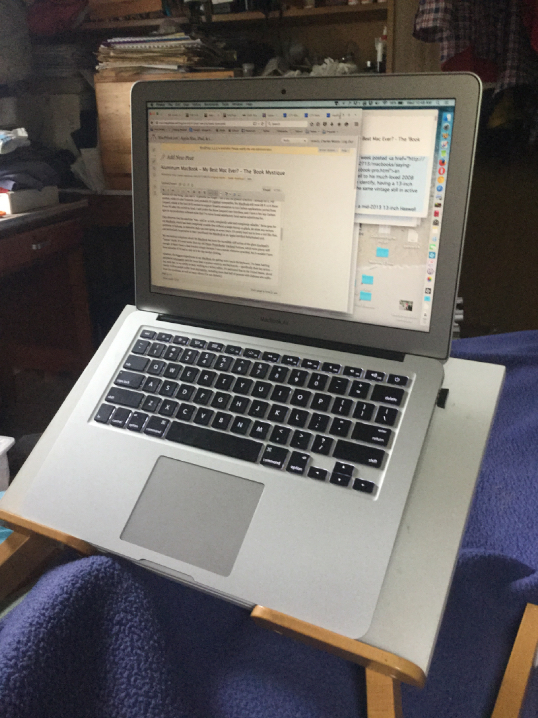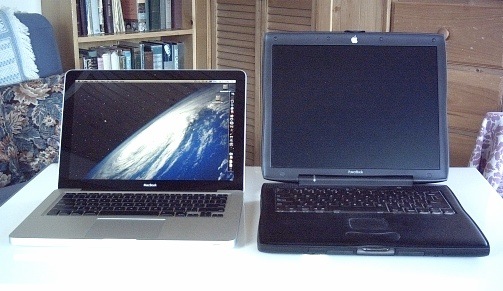Original Aluminum MacBook – My Best Mac Ever? – The ‘Book Mystique
Macworld’s Christopher Phin last week posted an affectionate retrospective farewell to his much-loved 2008 Unibody MacBook Pro. I can identify, having a 13-inch aluminum unibody MacBook of the same vintage still in active service.
I also have a newer Mac laptop — a mid-2013 13-inch Haswell MacBook Air, which is a lovely piece of work, and currently running OS X 10.10 Yosemite nicely. However, the old MacBook remains in very active front line duty because for one thing I just like it. In general the longer I use a tool the greater affection I develop for it. For another, while it’s also Yosemite (and probably El Capitan) compatible, the MacBook still runs OS X 10.6 Snow Leopard, which is the last OS X version to support Rosetta emulation to run Carbon applications ported from Power PC after the switch to Intel. I still prefer the Snow Leopard user interface, and I have a few key Carbon apps in my production software suite that I’ve never found satisfactory Intel-native substitutes for.
Phin observes that his machine “was—and is—a rock, completely solid and completely reliable.” Same goes for my MacBook, which has been completely trouble-free without a single hiccup or glitch, let alone any serious problems or failures, in intensive daily use over going on seven years. It’s pretty hard not to love a tool like that, and particularly impressive in that I purchased the MacBook as an Apple Certified Refurbished unit.
My one serious complaint about the MacBook has been the incredibly stiff action of the glass touchpad’s “button” mode. It’s even worse than my old Pismo PowerBooks’ trackpad buttons, which were plenty stiff enough. It hasn’t been a deal-breaker simply because I use a mouse whenever practical, but it wouldn’t have been tolerable if I’d had to rely on it for day-to-day clicking,
However, the biggest impediment to my MacBook Air getting more use is the keyboard. I’ve been battling peripheral neuropathy pain for more than a quarter-century, and keyboards — specifically their key action — are, well, key, to my ability to keep working as a writer/editor. It’s estimated that in the United States, about twenty million people suffer from neuropathy, including more that half of persons with diabetes who suffer from the condition, as well as many others (I’m not diabetic).
When I find a comfortable keyboard, I can type for hours on a daily basis with no problem, while 10 or 15 minutes on some ‘boards leaves me with pain, numbness, and a burning sensation in my hands, wrists, arms and shoulders that lasts for hours. An amazing aspect of this is that respective extremely subtle differences in keyboard action and feel can produce vastly distinct neuropathic aggravating effects — the keyboards in the old MacBook and the 2013 MacBook Air a keys being a salutary case in point.
I would guess that to most users, these two keyboards look and feel pretty much the same. They’re both similar ‘chiclet” designs with relatively short key travel and medium touch. However, I can go all day on the MacBook with no problem, banefully not so much on the MacBook Air’s ‘board. The difference appears to be that in slimming down the laptop design from the late 2008 unibody to the 2010 and later MacBook Air form factor, Apple shortened the key travel even more, which made the landing of keystrokes harder.
With keyboards in general I find that the most important factors are smoothness, uniformity of key action and a soft keystroke landing, rather than touch resistance and the distance of key travel per se. I generally find shortish travel and a light touch preferable, but the previously-noted factors are most important. Consequently, the MacBook Air gets most of its use at my office workstation where I currently use it with a superbly comfortable Logitech K-750 Solar Wireless Keyboard and an assortment of mice, while the old MacBook gets most of the literally hands-on laptop duty, even though the MacBook Air is otherwise much nicer to handle is portable mode being substantially lighter and thinner
An interesting aside is that I’ve found the virtual on-screen keyboard of my iPads also quite tolerable, even though touch input on a glass panel would seem to be the hardest of hard landings. However, the distinction is that there is no key spring action to overcome at all and the lightest of finger pressure on a “key” is all that’s required, which seems to equal lower stress on nerve axons.
One of the things I really like about the late-2008 MacBook is that unlike many Apple laptops to follow, its battery and storage drive are user-replaceable and the RAM is upgradable, all of which is potentially huge for folks like me who tend to keep their computers for a long time. Easy upgradability allowed me to squeeze 14 years of active production service out of a couple of 2000 Pismo PowerBooks that I still use frequently for certain utility tasks with period contemporaneous software and hardware peripherals.
That said, the only one of these three upgrade possibilities I’ve taken advantage of so far with the MacBook is bumping the RAM to 4 GB from the original 2 GB. It could definitely use a drive transplant, since the little 160 GB IBM hard disk drive is pretty packed out after six-plus years of service.
As for the original battery, a quick check with the coconutBattery utility indicates that it’s in amazingly decent shape after 79 months of service, during which it has spent most of its life plugged into wall current, still retaining 3,455 mAh or 84 percent of its original 4,100 mAh charge capacity. Not too shabby, although it pales by comparison with the 12-plus hour battery runtime with the MacBook Air, and of course if I was to use this old laptop on the road a lot, I would look into replacing the battery, but that’s not a likely scenario due to the stiff trackpad issue and also because it’s pretty heavy to lug compared with the MacBook Air and especially the iPad, and portability is what I have the iPad for anyway, n’est ce pas?
However, I love knowing that the potential is there to rejuvenate and upgrade the old MacBook, and I may still end up doing that with a fresh battery and a larger capacity HDD, as I’m still not totally convinced about SSD flash drives — quiet and speedy as they are. I’m going to wait and see what emerges as the much-rumored 12-ish inch iPad Pro or Air Plus before making any decision.
The MacBook has a built-in optical drive, which is occasionally convenient, especially when you need an alternate boot drive or to rip a CD or DVD to disk. With the MacBook Air I’ve got along fine with an Aegis external hard disk drive and optical drive combo unit, but having to go cold turkey on optical drives would be a bummer.
The MacBook’s non-Retina 1,280 x 800 display is of course pedestrian by even the standard of the non-Retina 1440 x 900 panel in the MacBook Air, but I still find it perfectly usable — generous even compared with the 9.7-inch Retina display in my iPad Air 2.
In summary, it’s always a moving target, but at this point in time, so to speak, I would rate the late-2008 aluminum unibody MacBook as my favorite Mac I’ve owned and used so far in 23 years. I like it so much that I’m musing about picking up a later and more powerful but near identical form factor 13-inch MacBook Pro from Wegener Media, which has been my source of Pismos and parts in later years.




